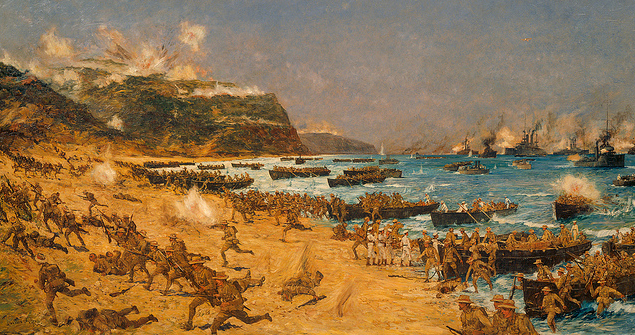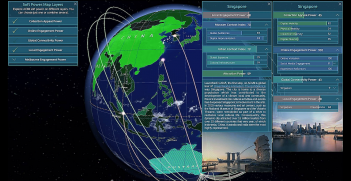Oil: The Underlying Reason for Gallipoli

A desire to control significant oil reserves can dictate the course of action during wartime.
The Ottoman Empire, which controlled the Middle East in 1914, became the centre of conflict between the British and the German Empires, both of which wanted access to its vast oil fields. The route the British took, initially via Gallipoli to capture Istanbul, continued in the Middle East and reached its victorious conclusion at the end of 1918. The reserves of oil in the Middle East then came under the control of the British Empire, which fulfilled a strategic objective that Churchill had devised almost a decade earlier. It seems that the Anzacs, unknowingly, assisted the British Empire in achieving this objective of Churchill’s.
On 26 June 1902, First Sea Lord of the Royal Navy Admiral John Fisher and Sir Marcus Samuel, Chairman of the Shell Transport Company at Portsmouth in the UK, watched the fuel oil trial of the HMS Hannibal. At stake was the potential conversion of the Royal Navy war ships from coal to oil firing. Due to a technical problem, the trial failed and the conservative Royal Navy did not switch to oil firing for another decade.
Crude oil is one of the most important strategic commodities in the world and has been so for over a century. The production, distribution and consumption of oil are all areas of strong interest of countries and any instability in that supply chain can cause economic chaos, as witnessed on several occasions in the past. The advent of the automobile-based society, in particular with the mass production of the Model T Ford which began in 1908, heralded this significant interest in oil which continues unabated today.
Even before the turn of the 20th century, oil companies were urging Britain’s Royal Navy to convert its coal-powered ships to oil fired engines. Senior naval officers readily accepted that oil firing offered significant advantages over coal: increased speed, extended range, smokeless burning, improved manoeuvrability, more space aboard ships for armaments, fewer crew members to oversea and the possibility of easy refuelling at sea rather than always docking for coal loading. The British Empire, however, lacked any known deposits of oil and this factor alone convinced most that conversion would not be in the Royal Navy’s best interests. In the meantime, the German Navy, which also lacked secure access to oil, was busily planning conversion to oil firing of its navy’s battleships.
In 1911, Winston Churchill was appointed First Lord of the Admiralty. He was convinced that oil was the right fuel for the navy. He saw oil as an imperative if the British Empire were to continue ruling the waves. In July 1913, in an address to Parliament he said: ‘We must become the owners or at any rate the controllers at the source of at least a proportion of the supply of natural oil which we require’. To partly achieve this goal, Churchill persuaded the British Government to buy two million pounds worth of shares in the Anglo Persian Oil Company. The parliamentary Act authorising the purchase received its Royal Assent in late July 1914, less than a week before the Great War began.
The presence of oil in Mesopotamia (now Iraq) had been noted since ancient times. The classical Greek historian Herodotus, for example, wrote of pitch (bitumen) being used as a binding agent in the walls of Babylon. German geologists had visited the area in 1871 and reported enthusiastically about natural seepages of oil. In 1914, Mesopotamia, as well as all of the Middle East, was part of the Ottoman Empire.
The Ottoman Empire, which was founded in what is today known as Turkey in 1299, reached its zenith in the 17th Century when it ruled most of the lands in Eastern Europe all the way to Vienna, most of North Africa and the Middle East. By 1914, the sick man of Europe, as it was known then, had shrunk considerably to include only where Turkey is today and the Middle East. The Ottoman Empire was on its last legs due to a backward economy, uneducated mainly peasant population, lack of military capacity and low morale. It had lost battles and territories in Libya, Serbia, Greece and Bulgaria from 1911 to 1913. In the European capitals the discussion was when rather than if the Empire would collapse.
The Germans were very keen to cultivate the Young Turks party, who came to power in 1908, as a friend in the hope of positive returns in trade and territory. In particular, the Germans sought control over the vast oil deposits that lay within the Ottoman lands in the Middle East. The Germans offered the Ottomans the financial capital and technical expertise to build a railway linking Berlin and Baghdad (capital of Mesopotamia). In return for their assistance, the Germans asked amongst other things that they be granted the mineral (including oil) rights twenty kilometres each side of the railway track. The project could not be carried out before the war due to strong objections from Russia and Britain. It was only partly completed due to the end of the war and the capitulation of the Ottomans in the Middle East, as will be explained later.
Germans were not the only ones at about this time to realise that oil was fast becoming an extremely valuable commodity and a great logistical weapon in wartime. Churchill, as the First Lord of the Admiralty, brought back Admiral Fisher from retirement to head the Royal Navy. Both Fisher and Churchill were very keen to convert the Royal Navy’s coal fired battleships to oil firing ones to ensure British Empire’s supremacy of the seas. The lack of British access to significant oil deposits no doubt worried the Government. Churchill’s July 1913 statement to Parliament showed that his solution was to take control of the Middle East. It is reasonable to assume that Churchill and the War Council made plans to invade the Ottoman Empire with the aim of dismembering it and having control of the Middle East’s oil.
In the classical way of thinking, the reasons for attacking the Ottoman Empire were listed as having access to Russian wheat and attacking the soft belly of Germany, reasons which simply do not stand up to scrutiny. The actual decision to declare war on Turkey came after two German warships bombarded Russian towns in Crimea and her navy in October 1914. These oil fired warships (Goeben and Breslau) escaped a chase by the Royal Navy in the Mediterranean and were given refuge in Istanbul. They were then bequeathed by Germany to the Turkish Navy, received Turkish names and flags and all its sailors wore Turkish hats to complete the picture.
In early 1914, prior to World War I, the Ottoman Empire was trying to remain neutral. Several attempts were made to sign a non-aggression pact with Britain, but these were rejected. So she was forced to side with Germany.
Churchill, it seemed, devised a strategy to capture Istanbul, the capital of the Empire, by forcing through the straits of Dardanelles with the greatest armada of the time. The official reason was the need to link with Russia. However, the strategic aim was most likely the oil fields of the Middle East. When unexpectedly, on 18 March 1915, the combined navies of Britain and France had to retreat after losing a third of their capital battleships, Churchill turned to a land-based strategy. It was planned that an 80,000 strong army would land at Gallipoli on 25 April 1915 and the British Government thought that they would “walk to Constantinople” (now Istanbul). This plan, the invasion of Gallipoli, also failed when one million men from both sides fought for nine months, with half of them becoming casualties and no headway made towards Istanbul, the capital of the Ottoman Empire.
After the retreat from Gallipoli, the British Government decided to advance in the Middle East, with the help of the Australian Light Horse and the New Zealander Mounted Division, towards the oil fields via a much more difficult route. The British Empire was so sure of the success of this war that a secret agreement was struck between France and Britain. The Sykes-Picot agreement, concluded on May 19, 1916, divided up the Arab territories of the former Ottoman Empire into spheres of influence. In its designated sphere, it was agreed that each country would be allowed to establish as much direct or indirect administration as it desired and as it was willing to arrange with the Arab State or Confederation of Arab States.
Under the Sykes-Picot Agreement, the Syrian coast and much of modern-day Lebanon went to France. Britain would take direct control over central and southern Mesopotamia, around the Baghdad and Basra provinces. Palestine would have an international administration, as other Christian powers, namely Russia, held an interest in this region. The rest of the territory in question – a huge area including modern-day Syria, Mosul in northern Iraq and Jordan – would have local Arab chiefs under French supervision in the north and British in the south. Also, Britain and France would retain free passage and trade in the other’s zone of influence.
The war in the Middle East from 1916 to 1918 eventually succeeded in achieving the British strategic objective of controlling rich oil fields. The casualties from both sides reached a million men during those three years, double the cost of Gallipoli in human terms.
The importance of oil had been proven beyond a doubt in this war; the Allies were never short of it whereas the Central Powers could not secure adequate supplies. During the war the number of cars and trucks in the British Army had grown nearly a thousand-fold and motorbikes more than two thousand-fold. One senior British politician, Lord Curzon, went so far as to say ‘the Allies floated to victory on a wave of oil’.
In the aftermath of the Middle East campaign, the Ottoman Empire capitulated on 30 October 1918 and it was partitioned amongst the British, French, Italians, Armenians and Greeks. Soon afterwards in 1919, a national independence movement swept Turkey with the Gallipoli hero General Mustafa Kemal as its leader. After three years of battles, the enemies were removed from Turkish lands and a new Republic of Turkey was declared in 1923 with Mustafa Kemal as its first president. The location of the borders of Turkey in the Middle East was one of the difficult areas of negotiation during the discussions of the Treaty of Lausanne. It is now easy to see that the border between Iraq and Turkey was drawn to exclude any significant petroleum reserves for Turkey.
Hence, although the 1915 Gallipoli campaign was a failure for the Allies, within a decade the British Empire had achieved its long-term strategic aim of gaining control of vast reserves of crude oil in the Middle East.
In 1925, the newly formed Iraq Petroleum Company, a joint concern of British, French and American oil interests, received a 75-year concession to exploit crude oil reserves. In 1927, one of the biggest oil fields in the world, Baba Gurgur, near Kirkuk (in Iraq today) was discovered, which is still producing significant quantities of oil.
In conclusion, the British Empire’s desire to have access to the vast oil fields of the Middle East, which were under the Ottoman Empire’s rule at the time, was the driving force for the attack on Turkey. The initial strategy was launched on 18 March 1915 with a huge armada attempting to go through the Straits of Dardanelles to capture Istanbul. When that failed, Gallipoli was invaded: this also failed after a nine-month campaign. Then the difficult task of capturing the Middle East after a three-year campaign concluded with victory at the end of 1918. The British, with the help of the French, then designed the Middle East, by creating nation states, while ensuring that access to the oil fields remained with the British, which benefitted the Allies significantly over many decades.
Dr John V. Basarin is a research fellow with Deakin University and author of several books on Gallipoli, telling the story from the Turkish perspective. A retired Chemical Engineer specialising in the oil and gas sector, John completed his PhD on Gallipoli in 2011. He can be reached at johnnyturk.aus@gmail.com. This article can be republished with attribution under a Creative Commons Licence.





